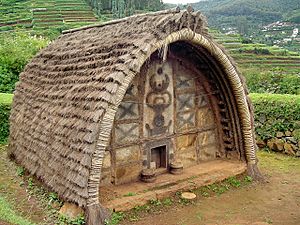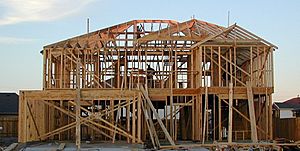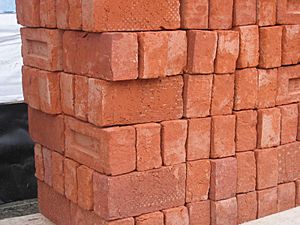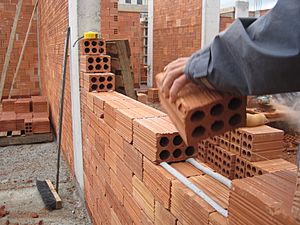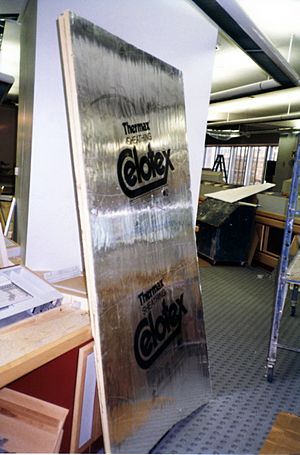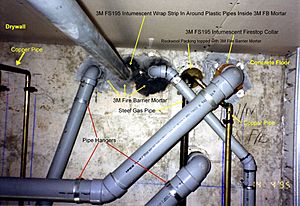Building material facts for kids
Building material is any material used to build things like houses, schools, and bridges. People have used many natural materials for centuries, such as clay, sand, wood, and rocks. Even twigs and leaves have been used! Besides natural materials, many man-made products are also used today, some of which are made from natural ingredients. For example, bricks are man-made but come from clay. Steel is also man-made but comes from natural iron. Sometimes, man-made materials like scagliola are created to look like more expensive natural ones, such as marble.
Exploring Natural Building Materials
Brush and Wattle and Daub
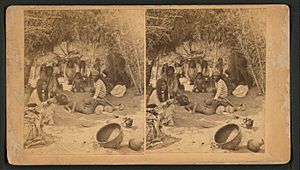
Some of the earliest buildings were made from plant parts like branches, twigs, and leaves. These "brush" structures were used by ancient cultures, including Native Americans and Pygmies in Africa. They were similar to a beaver's lodge and were called things like wikiups or lean-tos.
A more advanced way to build with brush is called wattle and daub. This method uses a woven brush frame, which is then filled and covered with a mixture of clay soil or dung (often cow dung). This makes the building stronger and better at keeping warm or cool. Wattle and daub is one of the oldest building techniques, and you can still see it in old timber-frame buildings where it fills the spaces between wooden beams.
Ice and Snow Structures
In cold places, people have used snow and ice to build shelters. The Inuit people, for example, built igloos from snow. Another snow shelter is called a quinzhee. Ice has also been used to create amazing ice hotels, which are popular tourist attractions in northern countries.
Mud and Clay Buildings
Buildings made from clay usually come in two main types. One type has walls built directly from a wet mud mixture. The other uses walls made by stacking air-dried blocks called mud bricks. Clay is also mixed with straw to make "light clay" or used as mud plaster to cover walls.
Wet-Laid Clay Walls
Wet-laid walls are made by using a mud or clay mixture directly, without making and drying blocks first. The exact mix of clay, sand or gravel, and straw or grasses changes the building style. For example, "cob" buildings use a lot of clay, while "sod houses" or "sod roofs" use soil with less clay.
Another old and new way to build walls is "rammed earth". In the past, people packed clay soils by hand between wooden planks. Today, machines with air-powered compressors are used to compact the earth into forms.
Soil, especially clay, is great at holding heat or cold. This means homes built with earth tend to stay cool in summer and warm in winter. Earthen walls change temperature slowly, so once they are warm or cool, they stay that way for a long time. People have built homes with earth and clay for hundreds of years in Europe, Asia, and other parts of the world, and some of these buildings are still used today.
Strong Clay Blocks and Bricks
Mud-bricks, also known as adobe, are ancient building materials that have been used for thousands of years. A more modern type is compressed earth blocks. These are made by machines in a central place called a brickworks and then taken to building sites. This makes them easier to sell and use in modern society.
Structural mud bricks are mostly made from clay soil, often with a binder. Other things like sand, lime, or stone can also be added. The blocks are air-dried and can be laid without mortar or with a thin clay paste.
Sand in Construction
Sand is a key ingredient in mortar, which is used to hold masonry (like bricks and stones) together. Mortar is made by mixing sand with cement and sometimes lime. Sand is also a big part of concrete. In countries with lots of sandy soil, a cheaper building material called a Sandcrete block is used. It's not as strong as fired clay bricks but costs less.
Building with Stone or Rock
Rock structures have been around for a very long time. Stone is the most durable building material and is often easy to find. Different types of rock have different qualities, making them suitable for various uses. Stone is very heavy and strong, offering great protection. However, its weight and difficulty to move are drawbacks. It also doesn't hold heat well, so stone buildings can be hard to keep warm without a lot of heating.
Dry-stone walls, built by stacking stones without mortar, have been made for ages. Later, people started using mortar to bind stones together, with cement being the most common today.
For example, in Dartmoor National Park in the United Kingdom, early settlers used the plentiful granite rocks to build circular huts thousands of years ago. You can still see the remains of about 5,000 of these huts today. Stone buildings are found in most major cities, and ancient civilizations like the Egyptians, Aztecs, and Inca built huge structures like pyramids entirely from stone. Slate is another type of stone often used for roofing.
Thatch for Roofs
Thatch, made from grass or reeds, is one of the oldest building materials. Grass is a good insulator and easy to gather. Many African tribes have lived in homes made of grasses and sand for centuries. In Europe, thatched roofs were common but became less popular as factories and better transport made other materials available. However, thatching is becoming popular again today, with new buildings in places like the Netherlands using thatched roofs.
Wood and Timber Construction
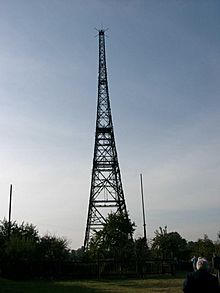
Wood has been used for building for thousands of years. Today, special "engineered wood" products are also very common. Wood comes from trees and other fibrous plants. It's cut into lumber and timber, like boards and planks, and used for almost any type of building in most climates. Wood can bend without breaking under weight and is incredibly strong when pressed down from above. Different types of wood have different qualities, so some are better for certain uses than others. How the trees are grown also affects the wood's quality.
"Timber" is the term used for wood in construction, though in the United States, "lumber" is often used. Raw logs become timber when they are cut or shaped into forms like logs stacked on top of each other, timber frames, or light-frame construction. The main problems with wooden buildings are the risk of fire and issues caused by moisture.
Today, softwood is often used for general building, while hardwood is used for finishes and furniture. Historically, timber-frame buildings in Europe were made with oak. More recently, douglas fir has become a popular wood for many structural buildings. Many families or communities in rural areas have a "woodlot" where they grow and harvest trees for building or selling. This was much more common before factories, when laws helped ensure a future supply of timber.
Man-Made Building Materials
Fired Bricks and Clay Blocks
Bricks are made similarly to mud-bricks, but without the straw. Instead, they are fired (baked in a brick clamp or kiln) after air-drying to make them permanently hard. Kiln-fired clay bricks are a type of ceramic material. Fired bricks can be solid or have holes to help them dry and make them lighter. Individual bricks are laid in layers using mortar to build walls, arches, and other parts of a building. Fired brick walls are usually thinner than cob or adobe walls but just as strong vertically. They take more energy to make but are easier to move and store than stone blocks. The Romans used fired bricks a lot. Building with bricks became very popular in the 18th and 19th centuries because they were cheaper to make and helped make cities safer from fire.
Later, in the 20th century, cinder blocks often replaced or were used alongside fired bricks, especially for the inner parts of walls. Structural clay tiles (clay blocks) are also made of clay and usually have holes.
Cement Composites
Cement-bonded composites are building parts made by mixing hydrated cement paste with wood, particles, or fibers. Different fibers like paper, fiberglass, and carbon-fiber have been used. Wood and natural fibers contain compounds that can slow down cement hardening. So, before using wood in these composites, its compatibility with cement is checked. This is often done by measuring how the cement heats up as it hardens.
From Roman times until the early 20th century, bricks were laid using lime mortar. Then, Portland cement mortar became common. Cement blocks are sometimes filled with grout or covered with a thin layer called a parge coat.
Concrete: A Modern Staple

Concrete is a composite building material made by combining aggregate (like gravel and sand) with a binder like cement. The most common type is Portland cement concrete, which uses Portland cement and water. After mixing, the cement hardens into a stone-like material.
Because concrete isn't very strong when pulled (low tensile strength), it's usually strengthened with steel rods or bars called rebars. This is called reinforced concrete. To make sure there are no air bubbles that could weaken the structure, a vibrator is used when the liquid concrete is poured around the steel. Concrete has become the main building material in modern times because it lasts a long time, can be shaped easily, and is easy to transport. New developments, like insulating concrete forms, combine concrete pouring with other steps like adding insulation.
Fabric Structures
Tents are the traditional homes for nomadic groups around the world. Two famous types are the cone-shaped teepee and the round yurt. Tents have become a major construction method again with new tensile architecture and synthetic fabrics. Modern buildings can use flexible fabric membranes, supported by steel cables, rigid frames, or even air pressure.
Foam for Insulation
Recently, synthetic polystyrene or polyurethane foam has been used with structural materials like concrete. It's light, easy to shape, and a great insulator. Foam is often used in structural insulated panels, where it's placed between layers of wood or cement, or in insulating concrete forms.
Glass in Architecture
Glassmaking is both an art and an industrial process. Clear windows have been used since glass was invented to cover small openings in buildings. Glass panes let light into rooms while keeping bad weather out.
Glass is usually made from sand and silicates, melted in a very hot kiln. It is very brittle. Other ingredients are often added to make glass different colors or give it special features, like bulletproof glass.
Using glass in buildings has become very popular today. Glass "curtain walls" can cover an entire building's outside, or glass can be used for wide roofs in a "space frame". These uses need a frame to hold the glass sections, as glass alone is too brittle for large areas. Glass bricks were also invented in the early 20th century.
Gypcrete: A Gypsum Mix
Gypcrete is a mix of gypsum plaster and fiberglass strands. While plaster and fibers have been used for ceilings for many years, it wasn't until the 1990s that people seriously studied using gypcrete for walls. Tests showed that these walls were strong, could support weight, resist earthquakes and fire, and had good insulation. Since gypsum is common worldwide, gypcrete products are good for the environment because they can be recycled.
Metal in Modern Buildings
Metal is used for the strong frameworks of large buildings like skyscrapers, or as an outer covering. Many types of metals are used in building. Metal is very important in prefabricated structures, like the Quonset hut, and you can see it in most big cities. Making the large amounts of metal needed for building takes a lot of human effort. Corrosion (rusting) is metal's main enemy when it comes to how long it lasts.
- Steel is a metal alloy made mostly of iron. It's the usual choice for metal building structures because it's strong, flexible, and lasts a long time if made well or treated.
- Aluminium alloys and tin are lighter and resist corrosion better, which sometimes makes them a better choice despite their higher cost.
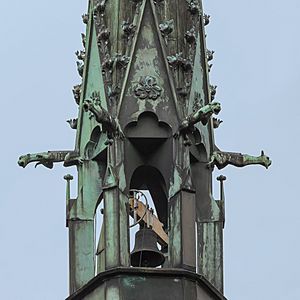
- Copper is a valuable building material because it resists corrosion, lasts a long time, doesn't expand much with heat, is light, blocks radio signals, protects against lightning, and can be recycled. Copper is used in roofs, gutters, domes, and even inside buildings.
- Other metals used include chrome, gold, silver, and titanium. Titanium can be used for structure but is much more expensive than steel. Chrome, gold, and silver are mostly used for decoration because they are costly and not as strong for building.
Plastics in Construction
The word "plastics" covers many man-made or semi-man-made products that can be molded or shaped into objects, sheets, or fibers. They get their name from being "plastic," meaning they can be easily shaped when soft. Plastics vary a lot in how much heat they can handle, how hard they are, and how flexible they are. Because they are so adaptable, light, and consistent, plastics are used in almost all industries today. High-performance plastics like ETFE are great building materials because they are very resistant to wear and chemicals. Famous buildings using ETFE include the Beijing National Aquatics Center and the Eden Project biomes.
Papers and Membranes
Building papers and membranes are used in construction for many reasons. One of the oldest is red rosin paper, used before 1850 under walls, roofs, and floors, and to protect construction sites. Tar paper was invented in the late 19th century for similar uses and for gravel roofs. Tar paper has mostly been replaced by asphalt felt paper, and felt paper is now sometimes replaced by synthetic materials, especially for roofing and siding (like housewraps).
There are also many types of damp proofing and waterproofing membranes used for roofs, basement waterproofing, and as geomembranes.
Ceramics in Building
Fired clay bricks have been used since the time of the Romans. Special tiles are used for roofing, siding, flooring, ceilings, pipes, and more.
Images for kids
-
Concrete and metal rebar used to build a floor.
-
Wooden church in Bodružal in Slovakia.
-
This wall in Beacon Hill, Boston shows different types of brickwork and stone foundations.
See also
 In Spanish: Material de construcción para niños
In Spanish: Material de construcción para niños



